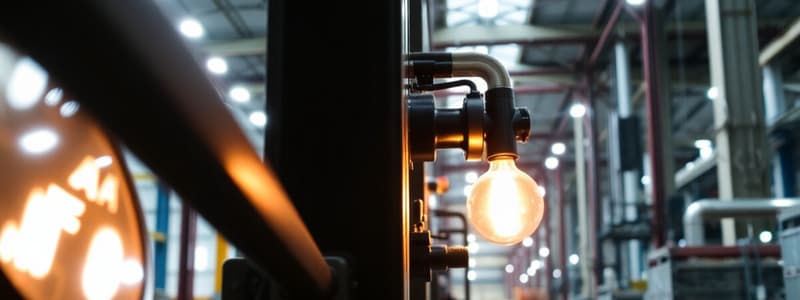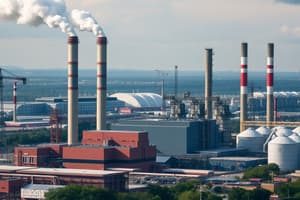Podcast
Questions and Answers
Which characteristic best differentiates a heavy industry from a light industry?
Which characteristic best differentiates a heavy industry from a light industry?
- The application of stringent environmental protection measures.
- The size and weight of raw materials and finished products. (correct)
- The reliance on advanced IT infrastructure for operations.
- The proximity to densely populated urban centers.
A paper mill is typically located close to forests. What type of industry is this an example of?
A paper mill is typically located close to forests. What type of industry is this an example of?
- Raw-material-oriented industry. (correct)
- Market-oriented industry.
- Ubiquitous industry.
- Footloose industry.
A bakery that produces fresh bread daily for local consumption is an example of which type of industry?
A bakery that produces fresh bread daily for local consumption is an example of which type of industry?
- A market-oriented industry. (correct)
- A bridge industry.
- A footloose industry.
- A raw-material-oriented industry.
What is a defining characteristic of a footloose industry regarding its location?
What is a defining characteristic of a footloose industry regarding its location?
Why is telecommunications (Telkom) considered an example of a ubiquitous industry?
Why is telecommunications (Telkom) considered an example of a ubiquitous industry?
An oil refinery located at a harbor, where crude oil is received and then distributed via pipelines, exemplifies which type of industry?
An oil refinery located at a harbor, where crude oil is received and then distributed via pipelines, exemplifies which type of industry?
Which of the following factors has most significantly contributed to the rise of footloose industries?
Which of the following factors has most significantly contributed to the rise of footloose industries?
What is the primary reason why a jewelry-making business is classified as a light industry?
What is the primary reason why a jewelry-making business is classified as a light industry?
Flashcards
Light Industry
Light Industry
Uses lightweight raw materials, light machinery, and produces small end products.
Heavy Industry
Heavy Industry
Uses large quantities of raw materials, heavy machinery, and produces bulky end products; often needs direct access to transport.
Raw-Material-Orientated Industry
Raw-Material-Orientated Industry
Located close to the source of raw materials due to bulky or difficult-to-transport raw materials.
Market-Orientated Industry
Market-Orientated Industry
Signup and view all the flashcards
Footloose Industry
Footloose Industry
Signup and view all the flashcards
Ubiquitous Industry
Ubiquitous Industry
Signup and view all the flashcards
Bridge Industry
Bridge Industry
Signup and view all the flashcards
Break-of-Bulk Industries
Break-of-Bulk Industries
Signup and view all the flashcards
Study Notes
- The study notes cover different types of industries.
Light Industry Vs Heavy Industry
- Light Industry: Lightweight raw materials, light machinery, small end product, no need for rail transport.
- Examples include: Jewelry making, clothing factories, and wineries.
- Heavy Industry: Large quantities of raw materials, heavy machinery, bulky end product, direct access to road, rail, and harbor facilities.
- Examples include: Iron and Steel Works, manufacture of tractors, and fuel refineries.
Raw-Material-Orientated Industry
- Found close to the source of the raw materials.
- The raw material could be bulky or difficult to transport.
- Example: A paper mill is found close to the supply of trees because it is easier to transport the finished product (paper) than the raw material (trees).
Market Orientated Industry
- An industry located close to the market.
- The finished product could be perishable, like baked goods.
- The finished product could be bulky and difficult to move, like large machinery.
Footloose Industry
- A Footloose Industry may be located either close to the supply of raw materials or close to the market.
- Improvements in transport have made it easier to transport both the raw materials and the processed product.
- The development of advanced IT has enabled factories to be located in diverse areas.
Ubiquitous Industry
- Found anywhere within a region.
- These Industries are inseparable from the immediate markets that they serve.
- They are widely distributed/found everywhere.
- An example is telecommunications (Telkom).
Bridge Industries
- These are located between the raw material and the market.
- For example, an oil refinery is located at a harbor.
- The raw material of crude oil is transported by an oil tanker to the harbor but once refined goes via a pipeline to the market.
- These industries are also referred to as break-of-bulk industries.
Studying That Suits You
Use AI to generate personalized quizzes and flashcards to suit your learning preferences.
Related Documents
Description
Explore different industry types: light, heavy, raw-material-oriented, and market-oriented. Understand their characteristics, locations, and the reasons behind their placement. Examples of each industry type are included.




